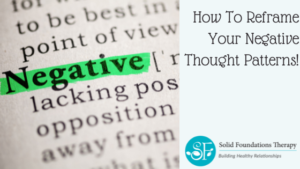
Have you ever heard of the term thinking through a negative lens? Has your negative thinking affected your relationship with others or yourself?
If so; you are not alone!
Unhelpful (negative) thinking, also known as cognitive distortions, is a thought pattern that is influenced by difficult experiences or triggers.
Unhelpful thinking can affect how you view or perceive things and can also affect your relationship with family, friends or your significant other. These types of thoughts can serve as a barrier in how you positively communicate, respond and connect with those you love.
For example, you may become triggered whenever you and your partner discuss the completion of household tasks. This discussion makes you feel frustrated and annoyed because the two of you can’t seem to agree on how to equally complete these tasks. Not only are you experiencing intense emotions, but you are also thinking negative thoughts like “My partner should clean the floors this way, everyone knows this” or “I am the only person in the world who has a partner who does not help around the house”.
So, how do you recognize when you are experiencing an unhelpful thought?
To understand your thoughts, you must know and understand the different unhelpful thinking patterns.
Below are examples of ten cognitive distortions, also known as negative thinking patterns. As you’re reading these distortions, identify the ones that you can relate to.
For instance, I personally struggle with the ‘all or nothing thinking’ distortion. I tend to look at things in absolute terms. I struggle with seeing “the gray” or other perspectives on certain issues.
10 Cognitive Distortions:
All-or-nothing thinking- You look at things in absolute extremes. This distortion can also be referred to as black-or-white thinking.
Overgeneralization- You develop a negative thought pattern based on a single event or you tend to be overly broad in the conclusions you draw.
Mental filter or selective– You dwell on the negatives and ignore the positives. You only pay attention to certain types of evidence.
Disqualifying the positive- You dismiss positive information or discount the good things that have happened. I.E. “This does not count”.
Jumping to conclusions- There are two ways you can jump to conclusions: Mind Reading or Fortune Telling.
- Mind Reading is described as assuming that people are reacting negatively to you when there is no evidence for this.
- Fortune Telling is described as predicting that bad things will happen or assume that others are thinking negatively about you.
Magnification and minimization- You blow things way out of proportion or you shrink their importance inappropriately.
Emotional reasoning- You reason from how you feel. “I feel like an idiot, so I must be one”.
“Should” statements- You criticize yourself or others with statements like “should”, “should not” or “must” or you reflect on your standards (often unreasonable) which leads to feelings of frustration, shame, or guilt. IE- “I should be better at this”.
Labeling and mislabeling- You identify with your shortcomings. Instead of saying, “I made a mistake” you tell yourself “I am a fool”. You can also apply this same notion into labeling other people.
Personalization and blame-
- Personalization- You blame yourself for something you weren’t responsible for.
- Blame- You blame other people and overlook ways your own attitude/behaviors contributed to the problem.
Do you or have you engaged in any of these thought patterns listed above?
The reality is we are all guilty of thinking negatively! The ultimate goal is to change your unhelpful thinking patterns to more helpful ones.
So, in order to do that lets discuss 5 coping strategies that you can use to assist with reframing your thoughts when you experience any of these negative thought patterns.

5 coping strategies to reframe negative thoughts:
- Examine the evidence: Instead of assuming your negative thought is true, examine factual evidence for this thought. You may find that your negative thought was rooted in irrational emotions.
- Ask friends or family members questions to find out if your thoughts and attitudes about this situation are realistic. You can even ask them questions about how they would think and respond in that situation.
- Step away from your thoughts. Engage in a healthy distraction like going for a walk, deep breathing exercises or watching a funny television show. Distractions help us re-center ourselves in efforts to mindfully and rationally change our thinking patterns.
- Engage in positive self-talk or affirmations. Speaking in positive terms helps with reframing your view of yourself and others.
- Use the wise mind tool to determine what is an irrational thought (emotional) vs a rational thought (logical).
Keep in mind, unhelpful thinking becomes an issue when your behavioral responses to yourself and others begin to change, your interpretation about the world around you is often negative or when you are struggling to make sense of your emotions related to a particular trigger or event.
Nonetheless, there are several ways to reframe negative thinking patterns.
For more information, check out The Feeling Good Handbook by David D. Burns, M.D.
Solid Foundations Therapy is also here to help you navigate these negative thought patterns. Visit our website at www.solidfoundationstherapy.com or give us a call at 630-633-8532 today!

